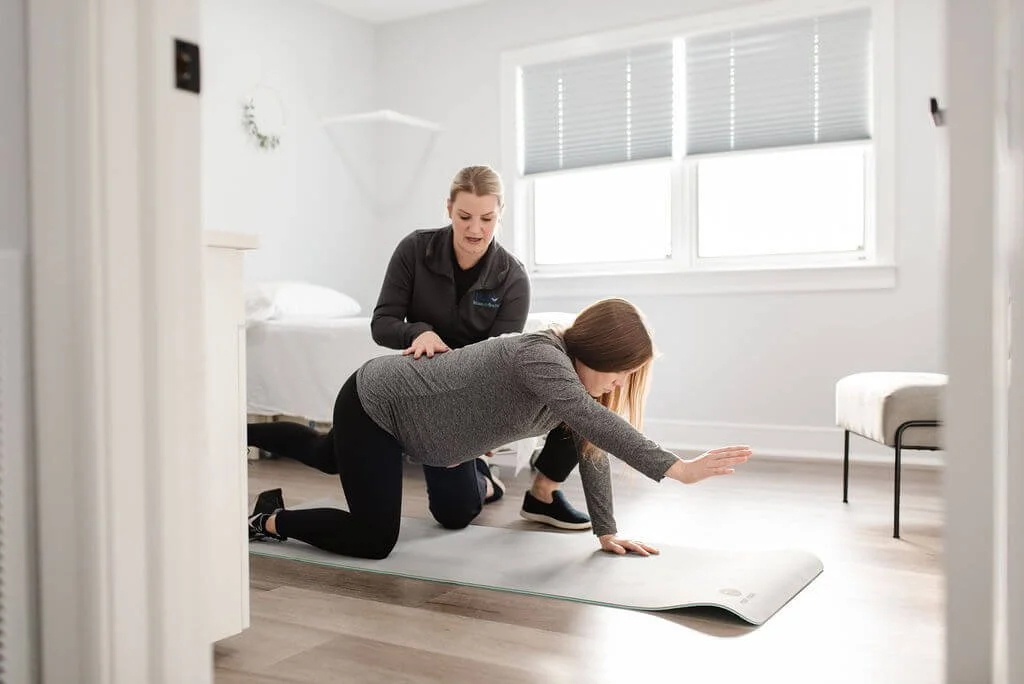Blog
Looking for something specific? Feel free to use the search bar below to find it!
Search by Category
Pelvic floor therapy
Postpartum Recovery
Prenatal Physical Therapy
Orthopedic Physical Therapy
Diastasis Recti Exercises to Avoid.
So how do you know what exercises to avoid with diastasis recti? The exercises to avoid with diastasis recti are person specific. In general, anything that makes the midline of your stomach bulge should be assessed by a trained professional.
Internal Tailbone Adjustment and Mobilization: Potential Benefits.
The internal tailbone adjustment (also known as mobilization) is typically most effective when combined with soft tissue mobilization to the pelvic floor muscles. Since the pelvic floor muscles attach directly to the tailbone, often these muscles can pull on the tip of the tailbone. Therefore, combining internal pelvic floor muscle release with internal tailbone adjustments, is often very effective at reducing tailbone pain.
Physical Therapy for Tailbone Pain.
Pelvic floor therapy is the best form of treatment for coccydynia (or tailbone pain). Pelvic floor physical therapists are specialty trained physical therapists that can perform internal assessments and treatments which are extremely effective at helping relieve tailbone pain. This is because the pelvic floor muscles have a direct attachment to the tailbone and therefore can be one of the main contributing factors to tailbone pain. Physical therapy often includes postural training/lifestyle modifications, pelvic floor relaxation exercises, massage and soft tissue release to the muscles surrounding the tailbone, and internal tailbone adjustments.
Guest Blog Post: Postpartum Hormone Levels
After giving birth, a mother’s hormone levels undergo many changes as her body transitions from pregnancy to the postpartum period. These hormonal shifts are essential for many processes, including uterine contraction, milk production, as well as emotional bonding with the baby.
Post-Hysterectomy Intimacy: Addressing Painful Intercourse After Hysterectomy
Painful intercourse after a hysterectomy is not uncommon. Hormonal changes, muscle tension and post-operative scar tissue can contribute to pain. Pelvic floor physical therapy is very effective at decreasing pain and improving quality of life after hysterectomy.
Diastasis Recti 101: Understanding Abdominal Separation
Any exercise can be a diastasis recti exercise. With diastasis recti, it is important that you challenge the core enough to lead to strength gains, but not too much to lead to worsening of the diastasis.
Diastasis recti exercises should be individualized. What is an appropriate challenge for one person, is not necessarily appropriate for someone else.
Postpartum Physical Therapy: Restoring Strength, Confidence, and Function for New Moms
Your body goes through major changes during pregnancy! From weakened pelvic floor muscles to aching joints and muscles, the postpartum period can take a toll on a woman's body. Regardless of delivery method, there has been a major change in how your body functions. Postpartum physical therapy helps women recover from pregnancy and is a specialty you may not be aware of.
How Out of Network Physical Therapy Can Enhance Your Rehabilitation.
Out of network physical therapy offers longer treatment sessions, allowing for more comprehensive assessments and targeted interventions. Specialized therapists cannot offer their entire skill set in a short session, or while they are also focusing on other patients. Extended time that is offered with out of network therapy enables your therapist to delve deeper into your condition, identify underlying issues, and develop a more personalized treatment plan.
How do I find a qualified pelvic floor therapist?
True pelvic floor therapy is conducted by a licensed physical or occupational therapist as it is a form of rehabilitative therapy. Speaking from a physical therapist perspective, physical therapists get a Doctor of Physical Therapy and their education includes learning about biomechanics (how our joints move), performing cadaver dissections to gain a full understanding of the musculoskeletal system, learning about how muscles truly strengthen (from a cellular level), gaining an understanding of the nervous system and what it actually takes for someone to learn how to do a new task, and become experts in various assessment and treatment techniques. Upon graduation, physical therapists can then pursue specialities, one of which is pelvic health. Those physical therapists that decide to focus their career on pelvic health then take a plethora of pelvic health specific post-doctoral courses to continue to gain knowledge in treatment of pelvic floor conditions. There are hundreds of pelvic floor courses through various education agencies and there is no way one person could take all of the courses in their career.
The Benefits of Pelvic Floor Physical Therapy During Pregnancy
There are so many benefits to coming in to pelvic floor therapy prior to delivering your baby. If you are symptomatic, we can address your current symptoms and concerns. Research shows that if you struggle with incontinence (leakage) and/or back pain during pregnancy, it likely won’t go away postpartum. Addressing your concerns before your baby comes into the world is the best thing you can do to set yourself up for success postpartum. In addition, birth/labor prep physical therapy sessions, while you are pregnant, can help teach you how to connect with your pelvic floor and set you up for a smoother delivery.
Physical Therapy For Diastasis Recti.
Diastasis recti (commonly known as abdominal separation) is a thinning of the tissue in the front of the core, between the two sides of the rectus abdominus (or 6-pack muscles). This thinning of tissue then causes the two sides of the rectus abdominus muscles to be separated. This separation can occur above, at, or below the belly button. Diastasis Recti can occur in anyone (it can occur in children and males) however it is synonymous with pregnancy and postpartum.
What Is Prolapse? A Guide to Understanding Prolapse, Causes and Treatment.
Prolapse, also known as pelvic organ prolapse (POP) is one of the top concerns that we treat as pelvic floor physical therapists. In its simplest form, prolapse is when there is a downward shift of the pelvic organs (your bladder, uterus/cervix, small intestine and/or large intestine). Prolapse occurs when there is a stretch to the support structures (mostly the ligaments) in the pelvic floor. The shift is organ position is graded from a slight shift (grade 1) to a significant shift (grade 4).
Why Your Pelvic Floor Rehab Needs to Consist of More Than Biofeedback.
Why do we have a problem with computerized biofeedback? There are many forms of biofeedback. Here are six reasons we aren’t a fan of biofeedback based treatment.
What is Biofeedback Therapy? A Guide and Explanation of the Popular Pelvic Health Modality.
What is biofeedback? In its simple form, biofeedback tells us whether your muscles are contracting or relaxing.
Hidden Causes of Constipation: Three Reasons You May Be Constipated.
What are three reasons that you may be constipated? Besides eating fruits and vegetables and ensuring that you are drinking enough water, there are three reasons that may be contributing to your constipation.
What is the best exercise for the pelvic floor muscles?
What is the best exercise for the pelvic floor muscles? This can differ from person to person, as each person’s needs are unique. However, in general the movement of our pelvic floor is vastly dependent on the movement on our diaphragm. Therefore diaphragmatic breathing is one of the top exercises that you can do for pelvic floor health.
What do I wear to pelvic floor physical therapy?
What do I wear to pelvic floor physical therapy? In order to understand what to wear, you want to be sure you understand what will happen at pelvic floor physical therapy. Loose fitting clothing is best recommended to allow your therapist to assess how your body is moving.
What to expect at your first pelvic floor physical therapy visit?
What to expect at your first pelvic floor PT visit? Your pelvic floor PT not only will discuss your current symptoms but will also perform external assessments to the pelvis and pelvic girdle, as well as an internal assessment either intra-vaginally or intra-rectally to determine how the pelvic floor muscles are functioning
What is pelvic floor physical therapy?
What is pelvic floor physical therapy and who does it help? Pelvic floor physical therapy is physical therapy to the pelvis and pelvic floor muscles (muscles that sit at the bottom of your bony pelvis).






















